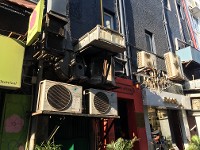12 June 2017
Global scenarios for F-gas emissions and the cost of a global phase down of hydrofluorocarbons
The fluorinated gases (F-gases) are synthetically produced gases with strong global warming properties. As described in a publication in Atmospheric Chemistry and Physics, researchers from IIASA’s AIR program have recently extended the GAINS model with the capacity to develop global future emission scenarios for the F-gases, hydrofluorocarbons (HFCs), perfluorocarbons (PFCs) and sulphur hexafluoride (SF6), with a resolution at the sector and technology level sufficiently detailed for policy-relevant emission reduction and abatement cost strategies. In another recent publication in Environmental Science and Policy, the enhanced GAINS model is used to provide, for the first time, a cost estimate of the global phasing down of HFCs, as agreed in October 2016 under the Kigali Amendment to the Montreal Protocol.
When accounting for existing regional and national F-gas regulations, pre-Kigali baseline F-gas emissions would be expected to increase from about 0.7 to 3.7 Pg CO2eq between 2005 and 2050, of which HFC emissions alone make up about 3 Pg CO2eq in 2050. Growth in emissions is particularly pronounced in developing countries owing to an expected strong increase in demand for stationary and mobile air conditioning. Assuming all countries adhere to their commitments under the Kigali Amendment, the post-Kigali baseline emissions in 2050 are expected to amount to 0.2 Pg CO2eq HFC emissions and 0.9 Pg CO2eq total F-gas emissions. The sector composition of future cooling demand differs considerably between developed and developing countries, which has implications for the abatement costs of adhering to the Kigali Amendment. Relatively more opportunities for low-cost or even profitable HFC abatement were identified in industrial and commercial refrigeration, which are sectors dominating cooling demand in developed countries, than in stationary and mobile air conditioning, which dominate cooling demand in many developing countries.
This is potentially important information when Parties to the Montreal Protocol meet later this year to set up the Multilateral Fund to alleviate some of the cost burden on developing countries to comply with the Kigali Amendment.
References
Purohit, P. & Höglund Isaksson, L. (2017). Global emissions of fluorinated greenhouse gases 2005-2050 with abatement potentials and costs. Atmospheric Chemistry and Physics 17: 2795-2816.
DOI:10.5194/acp-17-2795-2017.
Höglund Isaksson, L., Purohit, P., Amann, M., Bertok, I., Rafaj, P., Schöpp, W. & Borken-Kleefeld, J. (2017). Cost estimates of the Kigali Amendment to phase-down hydrofluorocarbons. Environmental Science & Policy 75: 138-147.
DOI:10.1016/j.envsci.2017.05.006.


